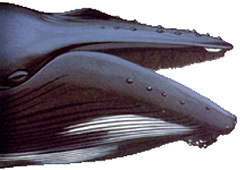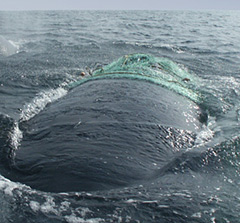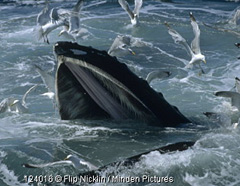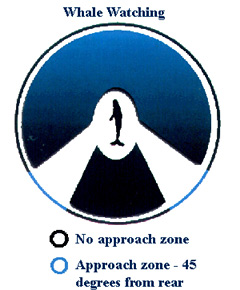 |
 |
 |
 Travel & Outdoors | January 2006 Travel & Outdoors | January 2006  
The Spectacular Humpback Whale - 3
 Griffin Page - Naturalist/Eco-Guide Griffin Page - Naturalist/Eco-Guide


| | 
| | Humpback caught in fishing net, photo courtesy of Astrid Frisch Jordán. | 
| | Bubble netting, photo courtesy of Flip Nicklin | 
| Proper Angles of Approach
drawing courtesy of SEMARNAT |
Megaptera Novaeangliae

Scientific classification
Class: Mammal (animals with hairs that nurse their young and breathe air through lungs)
Order: Cetacean (aquatic animal)

Suborder: Mysticeti (cetacean with baleen plates)

Family: Balaenopteridae (short triangular baleen plates, head length less than 1/4 of it's body length and has numerous grooves that extend from the chin to mid abdomen)

Scientific name: Megaptera novaeangliae (megas is Greek for big, pteron for wing or fin and from the Latin novus which means new and angliae for England. And so we have, the big fin from New England)

Feeding

The Humpback whale uses different techniques in order to feed. They are considered "gulpers" as all rorquals are. This, because of their numerous throat grooves that expand when taking huge gulps of food laden water. With their tongues, they then push the water out and only the food remains. Four different styles of feeding have been observed:

Assailing: This involves approaching the food from the bottom or the side while the mouth is wide open.

Corralling: In this case, they use their long pectoral fins to herd all the food in front of them.

Slashing: In making use of their tails, a powerful slash brings the food to the front of the whale.

Bubble netting: This is the most impressive of all techniques and leaves one to ponder on the level of intelligence and social structure of these incredible whales. This technique may involve one single individual or up to 16 whales. While under the water, they form a circle and swim one behind the other while releasing air creating a wall of bubbles that trap food in the center as efficiently as a fisherman's net.

The leader then emits a high piercing sound. This stuns the fish and forces them to gather in an even smaller bunch at the center. This is also a signal to all the other whales that it's time to surface, all at the same time, from the bottom up to gulp all the food collected through this technique. Amazing!

And if this isn't incredible enough, it has been shown, through many years of study, that each time a particular bubble net is formed, it includes the same individuals and they position themselves at their same designated positions. Somewhat like us at the dinner table, we all have our own seats and so do they! Things that make you go Hmmmmmm...

Threats

• Whaling by countries who ignore the ban.
• Entanglement in fishing nets and ocean garbage.
• Collision with ships.
• Pollution from runoff and coastal developments.
• Competition with commercial fisheries for food.
• Noise pollution from boats, sonar's, blasts, underwater mining and drilling.
• Whale watching activities performed without regard to rules and regulations.

In the Bay of Banderas, around 644 different individuals have been photo identified and included in the FIBB catalog (Photo Identification Bay of Banderas.) Some biologists, organizations, eco-tour companies and their guides participate in the conservation of this species by taking pictures of the underside of Humpback whale flukes and sending them to Astrid Frisch Jórdan who coordinates this catalog. Astrid Frisch Jórdan is a local marine biologist specialized in the study of the Humpback whale.


Please Help Us Save This Awesome Animal From Extinction

The whale watching industry has now replaced whaling. In many areas it plays a crucial role for the local economy. This should be a good thing, but one needs to be very careful when choosing their whale watching tour provider. Whale watching, if improperly conducted, can also be detrimental to the survival of the whales. I have seen whales with nasty lacerations from boat propellers; some don't survive the injuries.

I have seen a baby whale crazily leaping repeatedly out of the water in a desperate attempt to tell his mother that he couldn't keep up as she was swimming too fast while trying to evade too many boats that were well inside the legal distance for whale watching. The spectators of these boats were all applauding as if this was the greatest show they had ever seen, completely oblivious to the reality of the fear they were instilling on these beautiful creatures.

This doesn't have to happen. If you care about the survival of these wonderful creatures, here are a few questions you can ask the company you plan on calling on. This will help you evaluate the level of professionalism and integrity of the company in regards to conservation of this species.

• Do they have the proper accreditation and permits for the activity in question from the Secretary of Tourism?

• Do they provide experienced or trained guides that are aware of the regulations and abide by them?

Because the accredited companies incur a cost related to their permits, they will usually charge more than those that don't.

"Nature could be such a wonderful teacher if only we saw it for what it really is." --Monachí

Natural Treasures invites you to witness the beauty and to lend a hand in the conservation of our natural environment.

Griffin Page is a nationally certified whale watching guide as well as a very knowledgeable eco-tour guide. She helps in the research and conservation of Humpback whales and Olive Ridley marine turtles by conducting informative tours here in our Bay. Information on how you can give donations and other necessary materials or reserve a tour is available through her. Join her in this wonderful endeavor!

You can contact her through:
Natural Treasures Vallarta at:
044-322-888-4617 (from Puerto Vallarta)
naturaltreasuresvallarta@yahoo.com
NaturalTreasuresVallarta.com | 
 | |
 |



